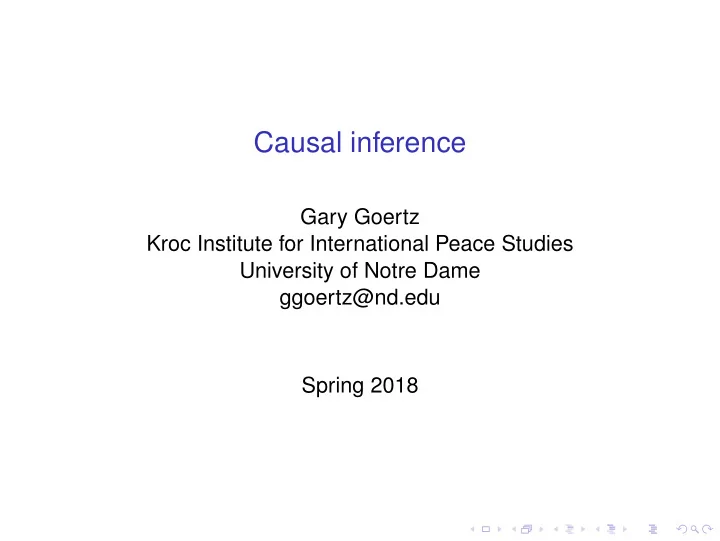

Causal inference Gary Goertz Kroc Institute for International Peace Studies University of Notre Dame ggoertz@nd.edu Spring 2018
Experiments are the gold standard for causal inference Strategies of causal inference are satisfactory (with respect to internal validity) insofar as they approach the experimental ideal. In this respect, there is a clear hierarchy of methods. (Gerring 2010, 257)
Fundamental Problem of Causal Inference It is impossible to observe the value of Y t ( i ) and Y c ( i ) on the same unit and, therefore, it is impossible to observe the effect of t on i . (Holland 1986, 947) The important point is that the statistical solution replaces the impossible-to-observe causal effect of t on a specific unit with the possible-to-estimate average causal effect of t over a population of units. (Holland 1986, 947)
Causal inference from observational data? There is perhaps no more controversial practice in social and biomedical research than drawing causal inferences from observational data. When interventions are assigned to subjects by processes not under the researcher’s control, there is always the real possibility that the treatment groups are not comparable in the first place. Then, any inferences about the role of the interventions are suspect; what one takes to be the causal effects of the interventions perhaps derive from “preexisting” differences among the treatment groups. (Gerring 2010, 256, epigraph)
Different causal models: statistical and set theoretic Quantitative methods: Y = β 0 + β 1 X 1 + β 2 X 2 + β 3 X 3 + . . . + β 12 X 1 X 2 + ǫ Qualitative methods: ( A AND B AND not C ) OR ( A AND C AND D AND E ) is sufficient for Y . ( A ∧ B ∧ ¬ C ) ∨ ( A ∧ C ∧ D ∧ E ) → Y . Y = ( A ∗ B ∗ c ) + ( A ∗ C ∗ D ∗ E ) ∗ Logical AND + Logical OR = logical If–Then, sufficiency
Necessary condition data: Admissions to a leading sociology program, 2009 Quantitative GRE < 620 > 620 Admit 1 34 No Admit 98 209
Explaining admissions to graduate school Set theoretic model: Y = T ∗ G ∗ ( U + L ) . Statistical model: Y = β 0 + β 1 T + β 2 G + β 3 U + β 4 L + ǫ Variables: T – test scores G – GPA U – undergraduate institution L – letters of recommendation)
Explanations of failure are different from than for success Failure model: ¬ Y = ¬ T + ¬ G + ( ¬ U ∗ ¬ L ) . Variables: T – test scores G – GPA U – undergraduate institution L – letters of recommendation)
Table 1. Core Ideas of the Traditional Causal Theories. Account Core idea Probabilistic causation The occurrence of C alters the chances of occurrence of E. Counterfactual causation C causes E means: If C had occurred, E would have occurred, and if C had not occurred E would not have occurred either. Regularity or regularism C causes E means: Instantiations of E regularly follow instantiations of C. Necessary and sufficient causation Necessary and sufficient causation (INUS): Causes are insufficient, but a nonredundant part of an unnecessary but sufficient condition. Manipulation causation and invariance C causes E if manipulating C makes E occur and the relation between C and E is stable enough Mechanistic causation C causes E if there is a mechanism linking C to E. Agency causation Consideration and decision (C) to act by an agent causes agency- controlled behavior (E).
Hume’s famous quote We may define a cause to be an object followed by another, and where all the objects, similar to the first, are followed by objects similar to the second. . . . Or, in other words, where, if the first object had not been, the second never would have existed. (Daivd Hume An inquiry concerning human understanding )
Hume’s famous quote We may define a cause to be an object followed by another, and where all the objects, similar to the first, are followed by objects similar to the second. . . . Or, in other words, where, if the first object had not been, the second never would have existed. (Daivd Hume An inquiry concerning human understanding ) Hume’s ‘other words’ -that if the cause had not been, the effect never had existed are no mere restatement of of his first definition. They propose something altogether different: a counterfactual analysis of causation. (Lewis 1986, 160).
Recommend
More recommend